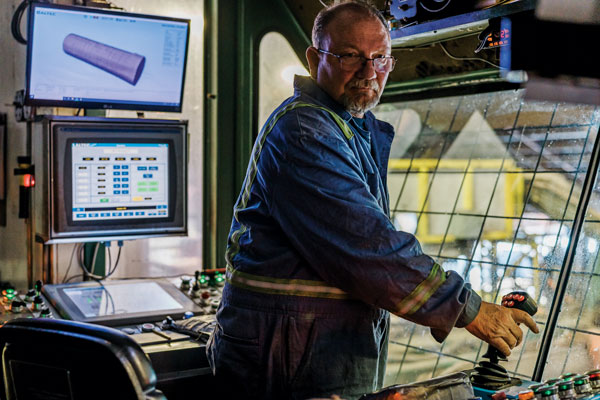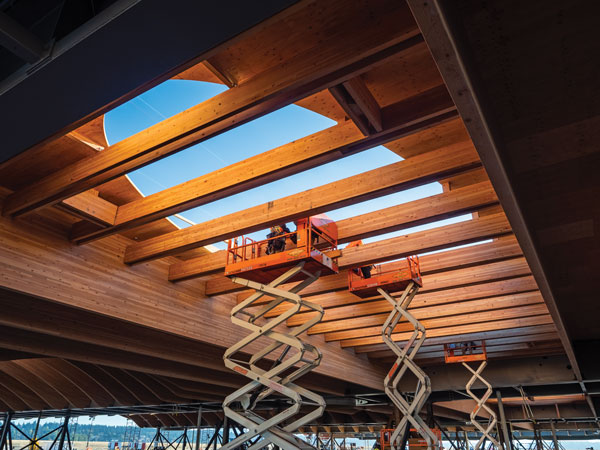Portland International Airport, already one of the nation’s best according to traveler surveys, is undergoing an upgrade that’s likely to wow passengers the world over. A $1.2 billion main terminal redevelopment to be completed next year includes a stunning pièce de résistance, a nine-acre roof composed of some 2.5 million board feet of engineered timber. It’s intended as a tribute to Pacific Northwest wood, one of the region’s most iconic and identifiable products. Freres Engineered Wood, a pioneer in mass timber technology based in Lyons, supplied mass plywood panels for the project, largely sourced from wood fiber salvaged from wildfires.
“People here really love wood,” says Judith Scheine, professor of architecture at the University of Oregon. “And if it isn’t beautiful,” she observes, “why would you want to build it?”
As the top producer of softwood lumber in the U.S., Oregon has deep roots in mass timber construction, a growing trend in architecture that utilizes engineered wood panels as primary structural components.
 “Forest to Factory”
“Forest to Factory”
Photo courtesy of Freres Engineered Wood
“Forest to factory” projects have the potential, Schein believes, to deliver broad-based benefits ranging from improved forest stewardship to better human health to economic development.
“The state,” she says, “is extremely interested in the possibility of creating these new manufacturing jobs in rural areas, which is where the trees are. Rather than clear-cutting logs and just shipping them to Asia, what you’re doing is turning them into a value-added product and along the way creating jobs that are higher tech and higher paying.”
Portland-based Timberlab, a leading mass timber provider, plans to create 100 such jobs in Oregon’s rural, mid-Willamette region through an investment announced in March. The company says its cross-laminated timber (CLT) manufacturing facility, to cover some 250,000 sq. ft., will be one of the largest of its kind, “a significant milestone,” Timberlab said in a statement, in its mission to accelerate the mainstream adoption of mass timber construction across the United States.
“Building this state-of-the-art manufacturing facility,” the statement said, “will drive innovation and position Timberlab and the State of Oregon as catalysts in mass timber construction.”
A Boost for Rural Oregon
Oregon, with its 30 million acres of forestland, is home to some of the country’s leading wood and paper product manufacturers, including Weyerhauser, Georgia-Pacific, Hampton Lumber and Roseburg Forest Products. Roseburg is nearing completion of two new manufacturing plants in southern Oregon, part of a $700 million capital project considered to be the largest-ever manufacturing investment in rural Oregon.
“We’re creating more of a market for mass timber products by creating modular mass timber housing.”
— Prof. Judith Scheine, University of Oregon
“Roseburg is embracing advanced manufacturing and leveraging new technology and methods to make our current products and develop new ones,” said President and CEO Grady Mulbery, announcing the investment in the spring of 2023. The company says the new facilities will employ about 120 rural Oregonians.
The investment is to include two high-tech manufacturing plants at the company’s Dillard Complex near the town of Roseburg, about three hours due south of Portland. Dillard MDF (medium-density fiberboard) will use residuals from Roseburg’s local mills and other regional mill suppliers to manufacture MDF panels and high-density fiberboard (HDF), typically used in cabinetry, doors and other applications.
A second plant is to convert specialty MDF panels manufactured at Roseburg’s plant Medford into Armorite Trim, a finished exterior trim product for residential use.
“Not only are we proud of our long history in this region, but our focus on advanced manufacturing and innovative technology makes us an excellent fit for the future of Oregon’s manufacturing sector as well,” Mulbery said. “Our use of robotics, computer programming and other advanced manufacturing tools aligns Roseburg with the high-tech evolution of manufacturing in this state.”

